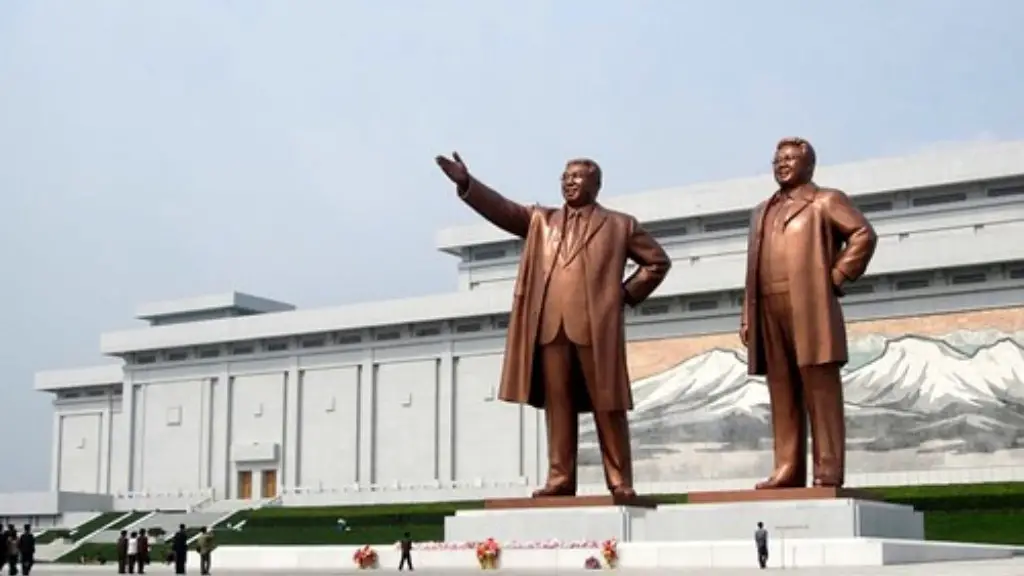North Korea is one of the most secretive countries in the world and little is known about its exports. Despite its restrictive trade policies, the country’s economy depends heavily on its exports, which account for around 16% of the country’s GDP. In recent years, the isolated country has diversified its export markets, sending goods to around 30 countries in Europe, Asia and Africa.
North Korea’s top exports are minerals such as coal, iron ore, copper ore and graphite. According to the United Nations, these minerals alone account for almost 60% of the country’s total exports and they have earned the nation hundreds of millions of dollars each year. North Korea is known to be one of the richest sources of minerals in the world and its ability to export minerals to improve its economy has made it strategically important for nearby countries.
Other exports from North Korea include weapons, pharmaceuticals and seafood. Weapons, consisting mainly of missiles and military hardware, are believed to account for about 20% of North Korea’s exports and have been sold to many countries, including Syria and Iran. Although North Korea is internationally condemned for selling weapons, it continues to do so to benefit from the high margins that such deals bring. Pharmaceuticals exports make up a small but significant portion of North Korea’s exports, with some products being exported to African and South American countries. The country’s seafood exports include fish, squids, crabs and other seafood and are largely sold to neighboring countries in Asia, such as China and Russia.
North Korea’s exports have always been subject to international trade sanctions and embargoes. Over the years, the country has managed to find ways around the sanctions, including using middle men to export its products. Despite the sanctions, North Korea’s exports have managed to increase steadily over the past decade. This is mainly due to the increased demand for its minerals and weapons from other countries.
More recently, the global COVID-19 pandemic has had a devastating effect on the North Korean economy. With fewer countries importing its goods, the country’s exports have now decreased significantly. The economic crisis has been further compounded by further international sanctions and the inability of foreign investors to travel to the country. This has left the North Korean economy in a very fragile state and with only a few remaining sources of income, its people are struggling to survive.
Tourism
Tourism is one of the few industries that North Korea has been able to tap into in recent years. Since its tourism industry was opened up to the world in the mid-2000s, the country has seen an influx of foreign tourists. This industry has proven to be a great source of income for North Korea as well, accounting for around 14% of its export revenues in 2019. The country has seen an increase in tourism from China, it’s largest source of tourists, however it has also seen more tourists from other countries such as the United States, the EU and South Korea.
As with its other exports, North Korean tourism is subject to many sanctions and embargoes, which hamper its ability to attract more tourists from other countries. Despite this, the country’s tourism industry continues to grow, as more tourists are drawn to its unique culture and landscapes. As part of its strategy to attract more tourists, the government has invested in various infrastructure projects, such as upgrading and building more tourist attractions, hotels and transportation networks.
Technology Exports
While North Korea is known to be technologically backward, the country has managed to export some of its know-how to other countries. North Korea has a history of selling its military technology to other countries, particularly to African nations. North Korea is also known to be a major supplier of counterfeit goods to many countries, including counterfeit cigarettes and fake luxury goods. This type of trade has become a lucrative income stream for North Korea and has allowed it to earn much needed foreign currency.
More recently, North Korea has been developing its technology sector, with the government investing heavily in research and development. The country has started to export some technology-related goods and services, such as software and IT services. The country is also making strides in the satellite industry and its satellite-launching capabilities open up more opportunities for international trade. Despite these developments, North Korea’s technology exports are still largely limited by international sanctions, which hinder its ability to expand its exports.
Manufactured Products
North Korea also exports a variety of manufactured goods, such as apparel, textiles and machinery. These goods account for around 10% of North Korea’s total exports and are believed to be sold mainly to countries in Asia, such as China and Russia. North Korea faces stiff competition in the apparel and textiles industry, so its goods are usually of lower quality and can be found at a cheaper price compared to other countries. North Korea also exports a variety of machinery, including agricultural machinery and construction equipment.
Sanctions Imposed by Other Countries
North Korea’s exports have been subject to many international sanctions over the years, hampering the country’s ability to trade. The United Nations, the United States and many other countries have imposed sanctions on North Korea for its nuclear activities and for its human rights violations. These sanctions have had a devastating effect on the country’s economy, with exports to many of its traditional markets being greatly reduced.
The sanctions have also affected North Korea’s ability to find new export markets. As trade ties between North Korea and other countries have been severed, the country is struggling to find new buyers for its goods. This has resulted in a decrease in North Korea’s exports in recent years, with the country’s economy facing a very uncertain future.
Challenges Faced by North Korea
Despite the various export opportunities available to North Korea, the country still faces many challenges in its international trade. Firstly, the country’s infrastructure is not well developed, which makes it difficult for international companies to do business in the country. Secondly, its scarce foreign currency reserves mean that it is unable to buy the necessary goods and services needed for production and trade.
One of the biggest challenges faced by North Korea is the international sanctions imposed by other countries. These sanctions restrict the country’s ability to trade with the outside world and prevent it from accessing the markets and technology it needs to further develop its economy. Finally, North Korea’s trading partners also impose restrictions on the types of goods they are willing to buy from the North, making it difficult for North Korea to diversify its exports.
The Potential of North Korea
Despite all the challenges faced by North Korea’s exports, the country has made great strides in increasing its export revenues in recent years. Its primary exports of minerals, weapons and technology have allowed the country to generate much needed income. The country also has great potential to expand its exports and become a leader in the global market, with its unique culture and products being attractive to foreign buyers.
However, for North Korea to fully realize its potential, it needs to be able to access the technology and markets needed for production and trade. This is something that will require the lifting of international sanctions and for the country to open up to foreign investment. Until then, North Korea will continue to rely on its exports to generate much needed foreign currency and to support its struggling economy.

